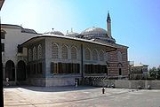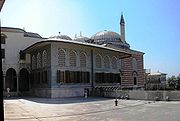
Kafes
Encyclopedia

Imperial Harem
The Imperial Harem of the Ottoman Empire was one of the most important elements of the Ottoman court. It was known in the West as "the Seraglio", an Italian term.- Harem quarters:...
of the Ottoman
Ottoman Empire
The Ottoman EmpireIt was usually referred to as the "Ottoman Empire", the "Turkish Empire", the "Ottoman Caliphate" or more commonly "Turkey" by its contemporaries...
Palace where possible successors to the throne
Throne
A throne is the official chair or seat upon which a monarch is seated on state or ceremonial occasions. "Throne" in an abstract sense can also refer to the monarchy or the Crown itself, an instance of metonymy, and is also used in many expressions such as "the power behind the...
were kept under a form of house-arrest and constant surveillance
Surveillance
Surveillance is the monitoring of the behavior, activities, or other changing information, usually of people. It is sometimes done in a surreptitious manner...
by the palace
Palace
A palace is a grand residence, especially a royal residence or the home of a head of state or some other high-ranking dignitary, such as a bishop or archbishop. The word itself is derived from the Latin name Palātium, for Palatine Hill, one of the seven hills in Rome. In many parts of Europe, the...
guards.
The early history of the Ottoman Empire
Ottoman Empire
The Ottoman EmpireIt was usually referred to as the "Ottoman Empire", the "Turkish Empire", the "Ottoman Caliphate" or more commonly "Turkey" by its contemporaries...
is littered with succession wars between rival sons of the deceased sultan
Sultan
Sultan is a title with several historical meanings. Originally, it was an Arabic language abstract noun meaning "strength", "authority", "rulership", and "dictatorship", derived from the masdar سلطة , meaning "authority" or "power". Later, it came to be used as the title of certain rulers who...
. It was common for a new sultan to have his brothers killed, including infants, sometimes dozens of them at once. This practice reduced the number of claimants to the throne, leading to several occasions where the Ottoman line seemed destined to end. The confinement of heirs provided security for an incumbent sultan and continuity of the dynasty.
First use
When Ahmet I died in 1617, his eldest son was only 13 years old, and for the first time in 14 generations, the Imperial Council altered succession so that the late sultan's brother acceded to the throne as Mustafa IMustafa I
Mustafa I Deli , son of Mehmed III, was the Sultan of the Ottoman Empire from 1617 to 1618 and from 1622 to 1623. His mother was Valide Sultan Handan Sultan, an ethnic Greek originally named Helena....
, aged 25 years. He was deposed (for the first time) the following year and became the first inmate of the Kafes although he and other princes throughout the preceding generations had been sequestered in various other places of comfortable confinement.
Rule of elderness
The next time there was a succession choice between a son or younger brother was in 1687 and the brother was again preferred. Thereafter, the "rule of elderness" was adopted as the rule of succession in the House of OsmanHouse of Osman
House of Osman was the name of the administrative structure of the Ottoman Dynasty, part of the state organization of the Ottoman Empire but nonetheless directly linked to the dynasty...
li so that all males within an older generation were exhausted before the succession of the eldest male in the next generation. This rule has also been largely adopted by other Islamic kingdoms.
It became common to confine brothers, cousins and nephews to the Cage, generally not later than when they left the harem (women's quarters) at puberty. This also marked the end of their education and many sultans came to the throne ill-prepared to be rulers, without any experience of government or affairs outside the Cage. There they had only the company of servants and the women of their harems, occasionally with deposed sultans.
The degree of confinement varied from reign to reign. Abdülaziz
Abdülâziz
Abdülaziz I or Abd Al-Aziz, His Imperial Majesty was the 32nd Sultan of the Ottoman Empire and reigned between 25 June 1861 and 30 May 1876...
(1861–76) confined his nephews to the Cage when he succeeded his half-brother Abdülmecid I
Abdülmecid I
Sultan Abdülmecid I, Abdul Mejid I, Abd-ul-Mejid I or Abd Al-Majid I Ghazi was the 31st Sultan of the Ottoman Empire and succeeded his father Mahmud II on July 2, 1839. His reign was notable for the rise of nationalist movements within the empire's territories...
(their father) on the throne, but allowed them some freedom. He took his 2 eldest nephews with him when he traveled to Europe in 1867. At different times it was the policy to ensure that inmates of the Cage only took barren concubines. Consequently, some sultans did not produce sons until they acceded to the throne. These sons, by virtue of their youth at the time of their fathers' deaths, ensured that the rule of elderness became entrenched so that it sometimes happened that the son of a sultan was confined during the reigns of cousins and older brothers before acceding to his father's throne.
Some inmates of the Cage grew old and died there before having the opportunity to succeed to the throne. Confinement in the Cage had a great impact on the personalities of the captives in the Kafes and many of them developed psychological disorders. At least one deposed sultan and one heir committed suicide in the Cage.
Later years
The last Ottoman sultan, Mehmet VI Vahidettin (1918–22) was aged 56 when he came to the throne and had been either in the harem or the Cage for the whole of his life. He was confined to the Cage by his uncle (Abdülaziz) and had stayed there during the reigns of his 3 older brothers. It was the longest and last confinement of a sultan by his predecessors.By the later years of the Ottoman dynasty, the Cage had become a metaphor for the confinement of princes rather than the actual place where they were confined. The heir of the last sultan had apartments in the Dolmabahce Palace
Dolmabahçe Palace
Dolmabahçe Palace located in the Beşiktaş district of Istanbul, Turkey, on the European coastline of the Bosphorus strait, served as the main administrative center of the Ottoman Empire from 1856 to 1922, apart from a 22-year interval in which Yıldız Palace was used.- History :Dolmabahçe Palace...
, on the Bosphorus, where the sultan also lived. The last sultan's deposed older brother (Abdulhamit II
Abdul Hamid II
His Imperial Majesty, The Sultan Abdülhamid II, Emperor of the Ottomans, Caliph of the Faithful was the 34th sultan of the Ottoman Empire...
) was confined in rooms of his own choosing at Beylerbeyi Palace
Beylerbeyi Palace
The Beylerbeyi Palace is located in the Beylerbeyi neighbourhood of Istanbul, Turkey at the Asian side of the Bosphorus...
in his final years and died there in 1918. The Topkapı
Topkapi
Topkapi or Topkapı can mean:* The Topkapı Palace in Istanbul, Turkey* Topkapı, a neighbourhood of Istanbul near the Roman city walls * Topkapi , a 1964 caper movie...
Palace, the original location of the Cage, had long fallen into disuse by the imperial family.

